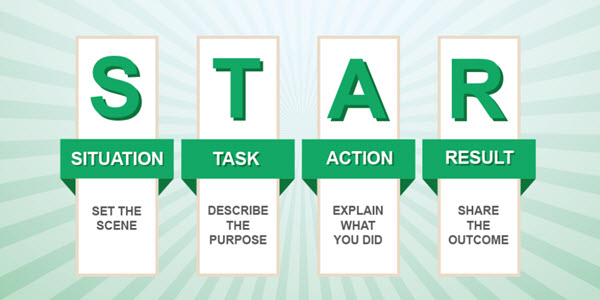How to Land Your Dream Job: The S.T.A.R Technique

Sally is a recent graduate looking to break into the consulting industry. She has prior internship experience and a stellar academic record. However, every time she’s invited to an interview, she freezes and doesn’t know what to say.
What can Sally do to better prepare for the questions she’ll be asked? How should she structure her responses to show her prospective employer how truly special she is?
If you are anything like Sally, knowing how to land your dream job is essential. That is where the S.T.A.R technique can help with your success.
What is the S.T.A.R technique?

It’s a job interview technique that allows interviewers to gather all the relevant information about a specific capability that the job requires. It stands for:
- Situation
- Task/Target
- Action
- Result
Using this technique, you’ll be able to craft a compelling answer that will highlight your talents and make your potential employer swoon. Let’s go through each section of the technique individually.
Situation
Every great story begins by setting the premise of the tale.
The situation section describes the environment (time, place, context, etc.) of the answer you’re providing. This could be a restaurant you used to work at, an internship you had the previous summer, a prior job you had, etc.
For example, one of my S.T.A.R situations centered on my time as manager of a local restaurant in Phoenix. I would explain the situation by detailing the setting before continuing with my answer. Explaining the situation well for potential employers helps give context to the scenario.
Task/Target
Now that you’ve set the stage, it’s time to explain your task.
Be sure to include metrics in your task to help your potential employer see its value. An example of a well-elaborated task would be when I described the purpose of my senior design project.
As part of our project, our group was tasked with implementing a small-parts bagging machine into a manufacturing production line. This implementation would eliminate 2 part-time workers, which would translate into a yearly savings of $60,000.
By clearly explaining the task and tying metrics to it, I was able to grab the attention of my interviewers and keep them on the edge of their seat.
Action
All great answers center on the action taken by the individual to resolve the problem. This is the section where you get to show the interviewer how awesome you are. The action taken describes what you did, what skills you utilized and what behaviors/characteristics you exhibited to accomplish your goal.
Be sure to highlight the characteristics that line up with the skills your potential employer is looking for. If your interviewer values someone who has great eyes for details, focus on how you exhibited that characteristic in a past scenario.
In the example of the bagging machine implementation, I described how I coordinated with the senior design group to organize weekly problem-solving meetings and how I compiled our time study data to create a solution proposal. I also explained how I worked with the team to navigate through the red tape of the organization.
All these actions highlighted skills that were valuable to potential employers.
See Also: Warmth or Competence: What Job Interviews Are Looking For
Results
Employers are always searching for candidates who can consistently deliver results to their organization. Your ability to convey how you’re able to drive results will largely determine whether or not you’ll get the position. Providing clear and concise metrics will help your interviewer get a better picture of what you bring to the table.
An example I often referenced in interview situations was my business venture “Pasticity”. As a result of our hard work and determination to grow the company and develop a solid mission, we were accepted into the highly competitive business incubator called SeedSpot.
The program curriculum taught us how to develop our brand and effectively grow a start-up. Highlighting these events showed the interviewer what positive results he/she could expect from me in the future.
Putting it into action
Now that we’ve covered how to structure your answer, let’s walk through a scenario where a Sally uses the S.T.A.R technique to effectively answer an interview question.
Sally is applying for a position as a financial analyst at a multinational bank. The job requires her to give clear and concise presentations and have a strong grasp of finance concepts.
If her potential employer asked, “Tell me about a time you worked on a team and what was the outcome?” She could tailor her answer by focusing on the 3-key candidate characteristic mentioned previously.
The average answer:
“An example of a time I worked on a team was during my senior design project. The subject of our senior design project was “Come up with an investment strategy that yields 12% per year over the next 3 years”. For about 2 months, we worked together to come up with the strategy. We finally did and we were able to meet the requirements of the project.”
Although this answer does follow the S.T.A.R technique structure, it doesn’t drive the point home that she was a valuable team member on the project. It doesn’t highlight the skills the employer is looking for, too.
The better answer:
“As part of our senior design project, our group was tasked with coming up with an investment strategy that would yield 12 percent growth per year over the next 3 years. I took the responsibility of leading the group and assigned different research assignments out to each of the project group members. Every week, I would follow up with each team member to support their progress. Once we compiled the necessary information about the various investment opportunities we’d researched, we began structuring our new investment strategy. Although there were obstacles along the way, we were able to utilize our critical thinking skills to work through them. When we finalized our investment portfolio, I verified that the math and logic of the investment strategy were sound. In the end, we delivered our presentation and received an A grade for the project. We also had the opportunity to utilize our portfolio to compete in a local finance competition.”
As you can see by Sally’s answer, she clearly described each section of the S.T.A.R technique and established herself as a valuable contributor to the team. This answer would bring Sally closer to achieving her ultimate goal of securing a full-time position.
Recommendation
My book recommendation for this article is “How to Win Friends and Influence People” by Dale Carnegie. In the book, Dale shares some timeless insights on how to become well-liked by the people around you. It also teaches how to influence people to make decisions that can benefit everyone.
I found the content of this book extremely helpful and have used many of the strategies in my own life. It’s one of the best business books out there and I highly recommend it. I’ve provided the link to the book here:
Raphael Collazo
Raphael Collazo is a millennial author and editor of The Strong Professional blog. An engineer by trade, Raphael has applied his analytical thinking to researching and condensing the most useful and effective strategies for Millennials into actionable content. He regularly speaks at local and regional events spreading his message of balanced living to other millennials.


